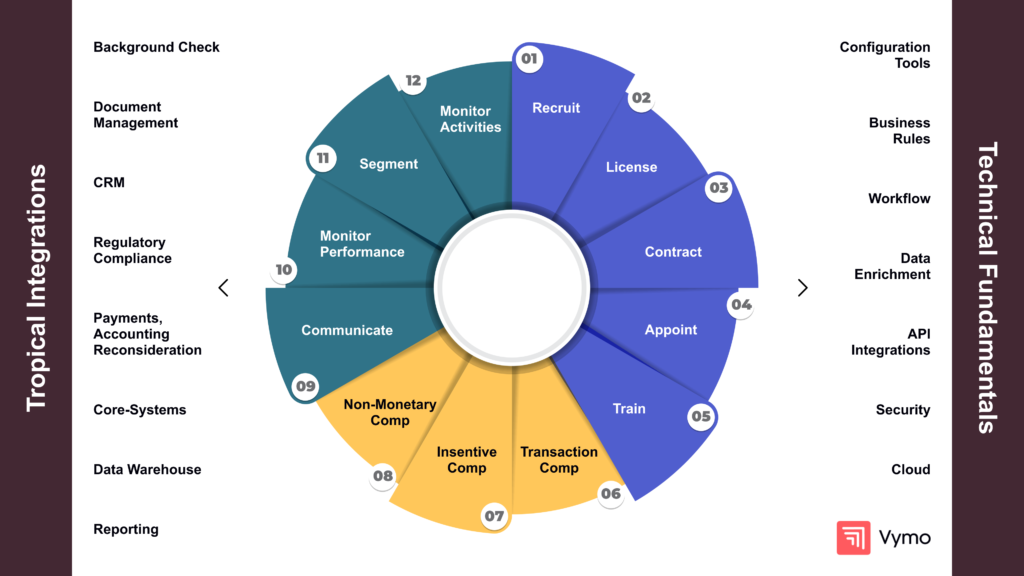BFSI organizations are facing a crucial question: How to keep pace with the rapid changes in customer behavior, technology, and distribution models? The answer lies in cracking the code to more agile and efficient distribution management. In this blog, we’ll unlock the secrets to building a system that seamlessly integrates your channels, elevates your sales strategies, and positions you ahead of the competition in an increasingly dynamic market.
Unpacking the Roadblocks: What’s Holding Back BFSI Sales?
As the BFSI sector grows and diversifies, distribution networks are becoming increasingly complex. Traditional agents, digital sellers, relationship managers, and direct distributors are all part of the mix. However, these different players often work in silos, which creates inefficiencies and missed opportunities. Here are some key challenges:
- Fragmented Data: Sales teams often lack a unified view of customers, leads, and opportunities, making it difficult to make informed decisions.
- Manual Processes: Disconnected systems and manual tasks slow down operations and hinder agility.
- Coordination Issues: With multiple channels and players, there’s often a lack of alignment, leading to missed opportunities and duplication of efforts.
- Regulatory Pressures: Increasing regulatory requirements demand that organizations maintain compliance while also ensuring smooth operations.
- Customer Expectations: Customers expect a personalized, seamless experience across all touchpoints, but without integration, this is hard to achieve.
- Competitive Landscape: Digital-first competitors are setting new benchmarks, making it essential for BFSI organizations to adapt quickly.
Why Traditional Tools Aren’t Cutting It Anymore
Many BFSI organizations rely on outdated systems that can’t keep up with these evolving challenges. Traditional CRM and lead management tools are limited in several ways:
- Narrow Functionality: These systems lack the versatility required for multi-line business (LOB) operations.
- Poor UI/UX: The user interface is often clunky, making it difficult for teams to navigate and utilize the system effectively.
- Lack of Mobile Access: Many systems aren’t optimized for mobile use, limiting sales teams’ ability to engage with leads and manage tasks on the go.
- Limited Insights: Sellers are not equipped with the real-time data and contextual guidance they need to make informed decisions.
- Inconsistent Engagement: Without contextual and automated playbooks, customer and lead interactions lack cohesion.
These limitations make it difficult for BFSI organizations to keep pace with customer demands and market changes.
Winning the Game with a Distribution Management System
A DMS is more than just a tool; it’s a strategic asset. Just like a coach guiding a sports team, a DMS helps align all players in your distribution network. By providing real-time insights, adaptive strategies, and streamlined processes, it ensures that everyone is working together efficiently. This alignment helps the team:
- Streamline Operations: Eliminate silos and create cohesive workflows across all channels.
- Enhance Channel Management: Gain complete visibility and control over distributors and sellers.
- Improve Customer Engagement: Deliver personalized, data-driven experiences that keep customers satisfied.
- Ensure Regulatory Compliance: Automate compliance processes to stay ahead of the curve and reduce errors.
- Stay Competitive: Leverage advanced technology to meet and exceed industry standards.
A well-designed distribution management system not only provides these capabilities but also helps organizations leverage AI and data to enhance decision-making and improve overall performance.

Conclusion
The BFSI sector is at a turning point. The inability to link information and manage distributors strategically is no longer sustainable. A Distribution Management System offers the tools and capabilities to address these challenges, transforming inefficiencies into opportunities.
By integrating data, AI, and scalable architecture, a DMS empowers organizations to deliver seamless, customer-centric sales experiences. It’s time to move beyond outdated systems and embrace a smarter way to manage sales and distribution.



